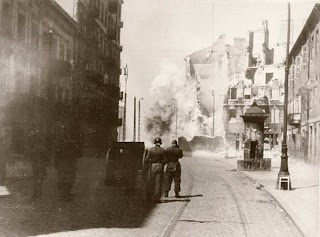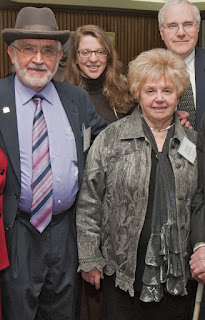 In the summer of 1944, Hirsh Glik disappeared from the ghetto in Goldfilz, Estonia, and was presumed dead. He was only twenty-two but had devoted his life to writing and had already established his legacy through the song, “Zog Nit Keynmol” (“Never Say”). This song was a triumphant and hopeful call for defiance, inspired by the Warsaw Ghetto Uprising. “Never Say” became a beacon to many and quickly grew to be known as the “Song of the Partisans.”
In the summer of 1944, Hirsh Glik disappeared from the ghetto in Goldfilz, Estonia, and was presumed dead. He was only twenty-two but had devoted his life to writing and had already established his legacy through the song, “Zog Nit Keynmol” (“Never Say”). This song was a triumphant and hopeful call for defiance, inspired by the Warsaw Ghetto Uprising. “Never Say” became a beacon to many and quickly grew to be known as the “Song of the Partisans.”Hirsh Glik was born in Vilna, Poland, in 1922. He demonstrated talent early: at age thirteen he began to compose poetry in Hebrew—and then solely in Yiddish—and his works were published frequently in the Jewish-Soviet press. When the Germans occupied Vilna in June 1941, Glik was sent to work the peat bogs in Biala-Waka, Rzesza. Displacement and grueling labor did not prevent him from writing: in between hauling impossible loads of turf, Glik would ask friends to hum a tune so that he could improvise lyrics. When Biala-Waka was liquidated in 1943, Glik returned to the ghetto in Vilna and joined the United Partisans Organization (FPO), where he took part in the literary scene. Here, Glik first recited “Never Say” to a poet friend, Shmaryahu Kaczerginski, at an event arranged to pay tribute to Yiddish writers, called “Spring in Yiddish Literature.” The scope of anguish, defiance, and hope in the song made it an anthem to many in Vilna.
Glik was also inspired by the actions of Vitka Kempner, a founding member of FPO, and wrote “Shtil, Di Nacht Iz Oysgeshternt” (Still the Night is Full of Stars) about her first act of sabotage, blowing up a Nazi train line.
The struggle to survive at Biala-Waka, Vilna, and later Goldfilz in Estonia, never broke Hirsh Glik’s inspiration to write. He composed sometimes on scraps but mostly in his head, reciting poems to other prisoners. Some written copies of Glik’s poems were discovered buried beneath the Vilna Ghetto. Though most of his words were lost, “Hymm of the Jewish Partisans” is considered worldwide one of the most important anthems of Jewish partisans and is still sung today in remembrance of those who died in the Shoah.
Hymm of the Jewish Partisans (audio)
Never say this is the final road for you,
Though leaden skies may cover over days of blue.
As the hour that we longed for is so near,
Our step beats out the message: we are here!
Never say this is the final road for you,
Though leaden skies may cover over days of blue.
As the hour that we longed for is so near,
Our step beats out the message: we are here!
From lands so green with palms to lands all white with snow.
We shall be coming with our anguish and our woe,
And where a spurt of our blood fell on the earth,
There our courage and our spirit have rebirth!
We shall be coming with our anguish and our woe,
And where a spurt of our blood fell on the earth,
There our courage and our spirit have rebirth!
The early morning sun will brighten our day,
And yesterday with our foe will fade away,
But if the sun delays and in the east remains –
This song as motto generations must remain.
And yesterday with our foe will fade away,
But if the sun delays and in the east remains –
This song as motto generations must remain.
This song was written with our blood and not with lead,
It's not a little tune that birds sing overhead,
This song a people sang amid collapsing walls,
With pistols in hand they heeded to the call.
It's not a little tune that birds sing overhead,
This song a people sang amid collapsing walls,
With pistols in hand they heeded to the call.
Therefore never say the road now ends for you,
Though leaden skies may cover over days of blue.
As the hour that we longed for is so near,
Our step beats out the message: we are here!
Though leaden skies may cover over days of blue.
As the hour that we longed for is so near,
Our step beats out the message: we are here!
Transliterated Yiddish:
zog nit keyn mol, az du geyst dem letstn veg,
khotsh himlen blayene farshteln bloye teg.
kumen vet nokh undzer oysgebenkte sho,
s'vet a poyk ton undzer trot: mir zaynen do!
zog nit keyn mol, az du geyst dem letstn veg,
khotsh himlen blayene farshteln bloye teg.
kumen vet nokh undzer oysgebenkte sho,
s'vet a poyk ton undzer trot: mir zaynen do!
fun grinem palmenland biz vaysn land fun shney,
mir kumen on mit undzer payn, mit undzer vey,
un vu gefaln iz a shprits fun undzer blut,
shprotsn vet dort undzer gvure, undzer mut!
mir kumen on mit undzer payn, mit undzer vey,
un vu gefaln iz a shprits fun undzer blut,
shprotsn vet dort undzer gvure, undzer mut!
s'vet di morgnzun bagildn undz dem haynt,
un der nekhtn vet farshvindn mit dem faynt,
nor oyb farzamen vet di zun in der kayor –
vi a parol zol geyn dos lid fun dor tsu dor.
un der nekhtn vet farshvindn mit dem faynt,
nor oyb farzamen vet di zun in der kayor –
vi a parol zol geyn dos lid fun dor tsu dor.
dos lid geshribn iz mit blut, un nit mit blay,
s'iz nit keyn lidl fun a foygl oyf der fray,
dos hot a folk tsvishn falndike vent
dos lid gezungen mit naganes in di hent.
s'iz nit keyn lidl fun a foygl oyf der fray,
dos hot a folk tsvishn falndike vent
dos lid gezungen mit naganes in di hent.
to zog nit keyn mol, az du geyst dem letstn veg,
khotsh himlen blayene farshteln bloye teg.
kumen vet nokh undzer oysgebenkte sho –
es vet a poyk ton undzer trot: mir zaynen do!
khotsh himlen blayene farshteln bloye teg.
kumen vet nokh undzer oysgebenkte sho –
es vet a poyk ton undzer trot: mir zaynen do!



 On October 7th,1944, at a line-up around three in the afternoon, a revolt in the Auschwitz concentration camp began with the swing of a hammer and a shout of “Hurrah!” from Chaim Neuhof, who had been a Sonderkommando – one of the prisoners selected to work in the gas chambers and crematoria – since 1942. The remaining Sonderkommando followed and assisted Neuhof in attacking the SS guards with hammers and axes that were smuggled in with the help of local partisans. An especially sadistic SS guard was thrown into the ovens after being stabbed - but still alive.
On October 7th,1944, at a line-up around three in the afternoon, a revolt in the Auschwitz concentration camp began with the swing of a hammer and a shout of “Hurrah!” from Chaim Neuhof, who had been a Sonderkommando – one of the prisoners selected to work in the gas chambers and crematoria – since 1942. The remaining Sonderkommando followed and assisted Neuhof in attacking the SS guards with hammers and axes that were smuggled in with the help of local partisans. An especially sadistic SS guard was thrown into the ovens after being stabbed - but still alive.
.jpg)











